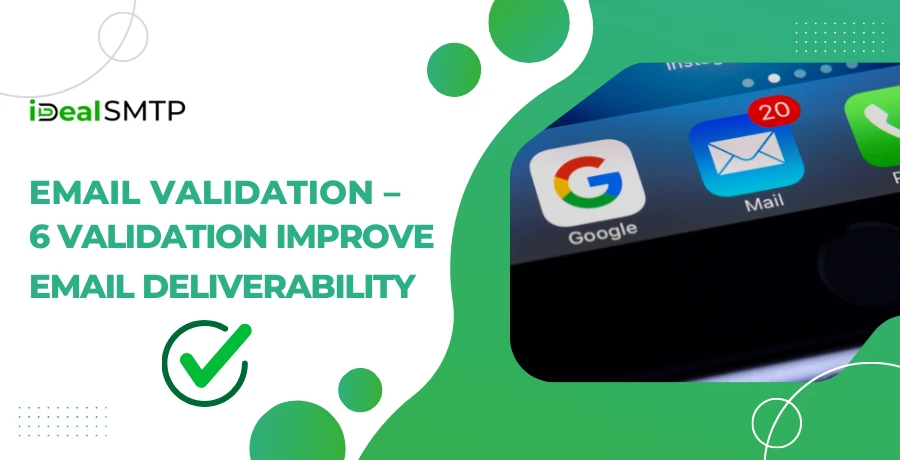In the world of email marketing, the term deliverability is synonymous with life. Regardless of the quality of your email marketing campaign, if the email never gets into the inbox, then all is for naught. Email validation remains one of the most significant predictors of your deliverability rates. If email validation is not done, it may lead to energy and time being chock, damaging the sender’s reputation, and finally having low chances of reaching and engaging your intended audience.

But let me explain why exactly the email validation is truly useful for your deliverability. In this blog, we will understand why email validation is important, the effect it has on deliverability, and how you can effectively ensure that your emails end up where they should – the primary inbox.
Table of Contents
Pricing
| Trail Plan | Standard Plan | Premium Plan | Professional Plan |
| $50 | $145 | $185 | $225 |
| Sending Limit | Sending Limit | Sending Limit | Sending Limit |
| 1000 Emails/Hour | 1500 Emails/Hour | 3000 Emails/Hour | 5000 Emails/Hour |
What is Email Validation?
Email validation is the process of establishing the accuracy, real activity, and ability of the address to receive a message. It is the best way to make sure that the email addresses, which you have in your mailing list are correct and that the corresponding mailboxes are active.
The email validation process typically involves checking the following:
- Syntax check: Pay attention to its format/e.g., [email protected].
- Domain check: To ensure firstly whether the domain is real and Secondly whether it accepts email addresses or not.
- MX record check: There should be an active mail server in a domain that should be able to receive mail.
- Disposable email check: Out of the example list, flagging the temporary email addresses that are used for one-time sign-up could negatively impact the deliverability.
- Blacklist check: Check if the email address or domain is on the blacklist as this influences delivery to specific inbox providers
Why is Email Validation Important for Deliverability?
The quality of your list determines your email deliverability or guarantees that your messages end up in the inbox rather than in the spam or junk folder. Here’s how email validation plays a crucial role in maintaining high deliverability:
1. Reduces Bounce Rates
One of the most important uses of any method of validating email addresses is to minimize hard bounces, the messages that are undeliverable because of permanent failure such as emails sent to non-existent or invalid addresses. A high bounce rate relays back to ESPs that you could be sending messages to clean or outdated lists which is a blow to your sender’s reputation.
It is quite best to validate emails before sending them out, this way you are left with working and good addresses only. This helps you minimize the instances where you get to send emails to wrong addresses thus maintaining low bounce rates and a good reputation.
2. Improves Sender Reputation
Sender reputation is one of the pillars that determine the delivery of your email messages. ISPs and ESPs monitor your sender reputation – a reputation that is developed from attributes such as bounce rates, spam complaints, and engagement metrics. If you always post your emails to invalid or inactive mailboxes, this will negatively impact your credibility and in the worst scenario, your emails will be automatically sorted into spam and even your domain could be blacklisted.
Using email validation is very effective when it comes to safeguarding the sender’s reputation because it only includes valid and active email addresses into consideration. A cleaner database helps to reduce the complaints and bounces thereby maintaining a good sender score.
3. Minimizes Spam Traps
Mail traps are old email addresses purposefully used to set Net’s SPAM traps. These are fake email addresses that are compiled and used by ISPs and email blacklist firms to lessen senders, who apply poor list management standards.
There are two types of spam traps: new innocent traps (new accounts that have never had a real person operate them), and reactivated innocent traps (inactive accounts that have been sold or given up by genuine users). Using spam traps as your target audience to send your emails can result in a blacklist in your domain which consequently reduced your deliverability.
Even though spam traps might cause a lot of harm, email validation tools can help in removing them from your list. By validating the list from time to time, then one can minimize sending the email to these traps thereby ensuring that the emails sent are not deemed to be spam_bo, function().
4. Enhances Engagement Rates
Because many people use invalid addresses, by sending your emails only to active, valid addresses, you maximize the likelihood of reaching those recipients who are likely to open, click, and engage with your emails. High open and click-through rates tell ESPs that your messages are wanted and therefore are a welcome part of the recipient inbox thus improving your sender reputation and reducing your chances of being filtered as spam.
Marketing to inactive addresses or those that rarely open your messages will also be damaging. Using email validation also means that those on the transmitted list are interested and willing to receive your stuff, boosting the general impact of your campaign.
5. Saves Time and Resources
Using Excel for updating the e-mail list can consume time you are bound to experience once you have many emails on the list. However, always reviewing the list minimizes the campaign’s time and effort on the list of fake addresses making your campaigns efficient. It assists in reducing the number of emails that never reach the intended recipients thus improving the further more the ROI on your emails.
6. Cuts Across Deliverability Problems by ISPs
every single ISP (Gmail, Yahoo, Outlook, etc.) has its rules for filtering spam. Such criteria may consist of verifying for high bounce rates, low interaction, or signs of a spam list. When you have a list of verified email addresses you stand less chance of provoking these filters and thus with the ones that you will send your emails will have a higher probability of reaching the inbox folders than the spam ones.
Best Practices for Email Validation
To get the most out of your email validation efforts and ensure high deliverability, here are some best practices to follow:

1. An email validation service should be used.
Purchasing SMTP services such as SMTPget, ZeroBounce or NeverBounce is probably the best method you can use to cleanse your list. All these services scan for several things such as grammatical errors and typos, disposable emails and inactive addresses and they can be incorporated into email marketing services so that validation of the entered information is done automatically.
2. Clean Your Email List As Often As Possible
Email verification is not a one-time process. Often enough, the emails themselves can become invalid, or simply unused and forgotten, thereby becoming ‘dead’ accounts. It is recommended that you clean your email list from time to time, for instance, every 3-6 months so that you get to foreplay any deliverability-specific issues while also ensuring your list is active.
3. Remove Hard Bounces Immediately
Any email that triggers the hard bounce should be deleted resulting from that email list. If you continue to send to these addresses, your brand and delivery rates will suffer and result in emails being reported as spam.
4. Monitor Engagement
In addition to email validation, pay careful attention to engagement metrics like open rates, click-through rates, and overall conversion rates. If many contacts do not open the letter, this means that the list has become stale, and it is high time to delete the inactive addresses.
5. Validate During Signup
In order not to collect bad email addresses from the beginning, it is necessary to add email validation during the registration step. This way, one only inputs the correct format, and valid e-mail addresses on the list since ‘invalid’ addresses cannot conform to the syntax.
Conclusion
Email validation should always be a part of any successful email marketing campaign. Email list validation can prove to be powerful when performed correctly as it gives you a guaranteed and verified list of active and genuine email ID addresses that help you build your sender reputation and boost your delivery rates and engagement levels. While best practices for list hygiene need to be kept in mind in managing your list, bounce management, spam traps, and blacklisting are some of the usual problems that you can encounter in email marketing.
In conclusion, the costs associated with the validation of the lists mail are costs worth investing in, in the long run, you’ll ensure the success of your email marketing campaign. You will be sure your emails are getting to the right people, at the right time, and with the greatest likelihood of achieving your campaign objectives.







